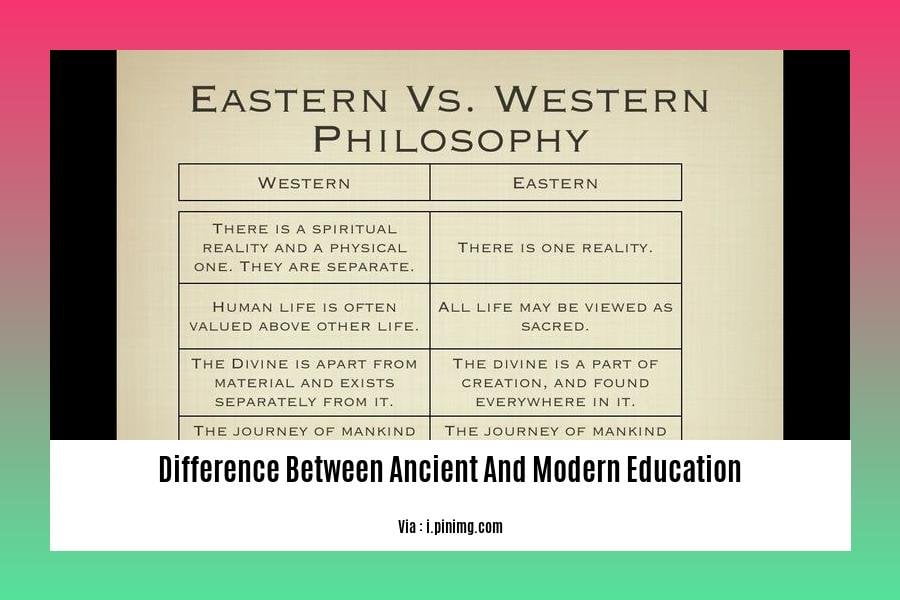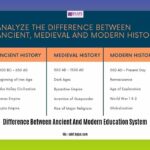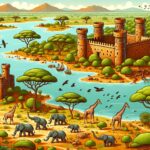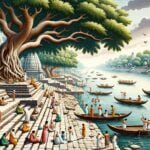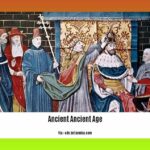Have you ever wondered how the classrooms of the past compare to the dynamic learning environments of today? Education has undergone a remarkable transformation, shifting from rote memorization to fostering critical thinking, creativity, and a lifelong love of learning. Let’s embark on a journey through time to explore the fascinating evolution of education, from its ancient roots to the modern classrooms of the 21st century.
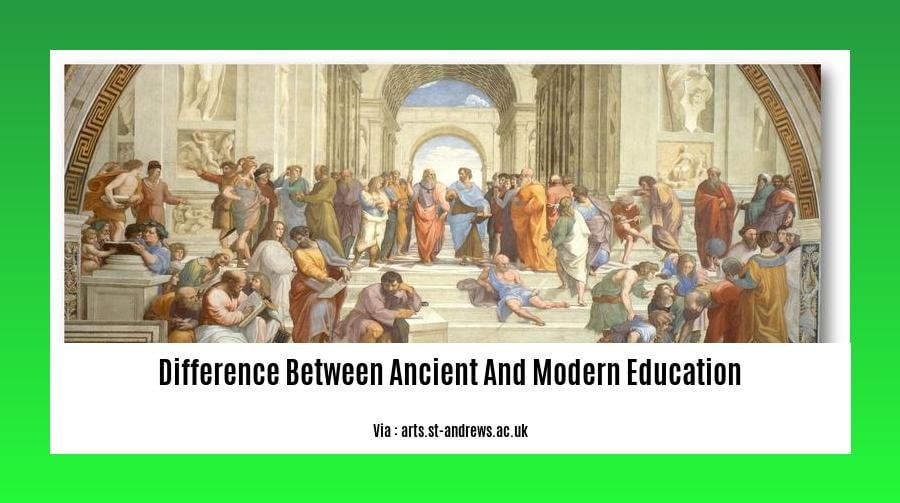
Difference Between Ancient and Modern Education
The modern classroom stands in stark contrast to its ancient predecessors. From pedagogical approaches to technological integration, the educational landscape has been reshaped to meet the evolving needs of society. Let’s delve into the key distinctions between ancient and modern education.
Back in the Day: Ancient Education
Imagine a classroom where silence reigns supreme, interrupted only by the rhythmic recitation of facts and figures. In ancient times, education primarily revolved around memorization and strict adherence to authority. Students were passive recipients of knowledge, expected to absorb information without questioning or critical analysis. Discipline was often harsh, with physical punishment used to maintain order and enforce compliance.
This approach, while effective in transmitting established knowledge, left little room for individuality, creativity, or the development of critical thinking skills. Knowledge was seen as a static body of information to be passed down from one generation to the next, rather than a dynamic and evolving realm to be explored and questioned.
Fast Forward to the Present: Modern Education
In contrast to the rigid structures of ancient education, modern classrooms pulsate with energy, collaboration, and hands-on learning experiences. Students are no longer passive recipients but active participants in their education, encouraged to think critically, solve problems creatively, and express their unique perspectives.
Collaboration is highly valued, with students working together to tackle challenges, share insights, and build upon each other’s ideas. Respect for individual differences is paramount, fostering an inclusive learning environment where all students feel valued and empowered to contribute.
Technology: The Game Changer
The rise of technology has been nothing short of revolutionary in the realm of education. From online courses that transcend geographical boundaries to adaptive software that personalizes learning based on individual needs, technology has democratized access to knowledge and transformed the way we teach and learn.
Interactive whiteboards have replaced traditional chalkboards, bringing lessons to life with vibrant visuals, simulations, and multimedia elements. Educational apps provide engaging and gamified learning experiences, making education both fun and effective. And with the vast resources of the internet at their fingertips, students can explore a universe of knowledge beyond the confines of textbooks and classrooms.
Finding Common Ground: Similarities
Despite their many differences, ancient and modern education share some fundamental goals. Both strive to equip individuals with the knowledge and skills necessary to thrive in their societies, foster social interaction and cooperation, and instill a love of learning that extends far beyond the classroom.
Modern Education: Breaking New Ground
However, modern education distinguishes itself through its emphasis on critical thinking, problem-solving, and preparing students for the challenges of a rapidly changing world. Innovation, creativity, and adaptability are highly prized, as are communication, collaboration, and the ability to think systematically and solve complex problems.
Modern education also strives to provide an inclusive and equitable education for all learners, regardless of their background, abilities, or learning styles. Technology plays a crucial role in this endeavor, providing personalized learning opportunities and breaking down barriers to access.
Let’s summarize the key differences between ancient and modern education in a table for easy comparison:
| Feature | Ancient Education | Modern Education |
|---|---|---|
| Focus | Memorization, conformity | Critical thinking, problem-solving |
| Values | Discipline, authority | Creativity, self-expression |
| Discipline | Often physical | Based on respect, communication |
| Technology | Limited to nonexistent | Integral part of learning |
| Student Role | Passive recipient of knowledge | Active participant in learning |
As we can see, education has come a long way from the days of rote learning and strict discipline. The classrooms of today are vibrant hubs of creativity, critical thinking, and collaboration, where technology empowers both students and educators to reach their full potential. And as we continue to evolve and adapt to the challenges of the 21st century, one thing remains certain: education will continue to play a vital role in shaping the minds of future generations.
The Rise of Modern Education – How Did We Get Here?
Key Takeaways:
- Ancient education methods emphasized memorization, discipline, and teacher-centered instruction.
- Modern education shifted towards critical thinking, problem-solving, and student participation.
- The Renaissance and Reformation brought a humanistic approach and individualism to education.
- The Industrial Revolution and Enlightenment led to a focus on science, technology, and workforce preparation.
- The 20th century saw progressive education emerge, emphasizing child-centered learning and experiential activities.
From Ancient Roots to Modern Classrooms: A Journey Through Time
To understand the rise of modern education, we must journey back in time to the classrooms of ancient Greece, where students huddled together, meticulously memorizing the words of Socrates, Plato, and Aristotle. These early forms of education, while groundbreaking in their pursuit of knowledge, relied heavily on rote learning and strict discipline.
The Seeds of Change: The Renaissance and Reformation
Centuries later, a period of profound intellectual and cultural transformation swept across Europe: the Renaissance. This era witnessed a resurgence of interest in classical learning, art, and literature, sparking a renewed focus on human potential and individual expression. The Reformation, a parallel movement challenging the authority of the Catholic Church, further emphasized the importance of individual interpretation and critical thinking.
These transformative movements challenged the rigid structures of medieval education, paving the way for a more humanistic approach that valued creativity, critical thinking, and the pursuit of knowledge for its own sake. Education was no longer solely about memorization and religious instruction; it became a means of personal growth, intellectual exploration, and societal progress.
The Industrial Revolution and the Rise of Practical Learning
The 18th and 19th centuries ushered in an era of unprecedented technological advancement: the Industrial Revolution. Factories sprang up across Europe and North America, demanding a skilled workforce capable of operating machinery, managing complex systems, and contributing to the burgeoning industrial economy.
In response to this demand, education underwent a significant shift towards science, technology, engineering, and mathematics (STEM). Public education systems emerged, aiming to equip citizens with the technical skills and knowledge required to thrive in this rapidly industrializing world.
The Enlightenment and the Power of Reason
Concurrent with the Industrial Revolution, the Enlightenment, a philosophical movement emphasizing reason, logic, and scientific inquiry, profoundly impacted educational thought. Thinkers like Isaac Newton and John Locke championed the power of observation, experimentation, and critical analysis, shaping educational philosophies that valued problem-solving, evidence-based reasoning, and a scientific approach to understanding the world.
The 20th Century: A Progressive Shift
The 20th century witnessed a paradigm shift in educational philosophy with the rise of progressive education. Influential thinkers like John Dewey argued that children learn best through hands-on experiences, active participation, and collaboration. They advocated for child-centered classrooms that nurtured individual needs, interests, and learning styles, fostering a love of learning and a sense of ownership over the educational journey.
This movement led to the incorporation of project-based learning, collaborative activities, and a greater emphasis on the social and emotional development of students. Education was no longer solely about academic achievement; it became about cultivating well-rounded individuals equipped with the skills, knowledge, and values to thrive in a complex and interconnected world.
The Digital Revolution: Education at Your Fingertips
And then came the digital revolution, perhaps the most transformative force in the history of education. The internet, computers, and mobile devices have democratized access to knowledge like never before, making information readily available to anyone with an internet connection.
Online courses, virtual classrooms, and educational apps have broken down geographical barriers, allowing students from all walks of life to access quality educational opportunities regardless of their location or circumstances. Adaptive learning platforms personalize the learning experience, tailoring content and pacing to individual needs and learning styles.
Looking Ahead: The Future of Learning
As we navigate the 21st century, education continues to evolve at an unprecedented pace. The rise of artificial intelligence, automation, and globalization presents both challenges and opportunities for educators and policymakers alike.
The classrooms of tomorrow will likely be even more personalized, interactive, and technology-driven. Virtual and augmented reality will create immersive learning experiences, while artificial intelligence will provide personalized feedback and support. And as we grapple with global challenges like climate change and social inequality, education will play a pivotal role in equipping future generations with the knowledge, skills, and values to create a more just and sustainable world.
- Dive into the stark contrast between the ancient and modern education systems and identify the significant shifts in teaching methods, curricula, and pedagogical approaches.
- Explore the fascinating evolution of the ancient and modern Olympics as we trace the changes in sports, rituals, and the spirit of competition over the centuries.
- Uncover the intriguing stories of the famous ancient Greek playwrights like Aeschylus, Sophocles, and Euripides, whose works continue to captivate audiences with their timeless themes and dramatic intensity.
- Embark on a journey through time as you follow the story of ancient Israel, witnessing the rise and fall of empires, the unfolding of biblical narratives, and the enduring legacy of a rich cultural heritage.
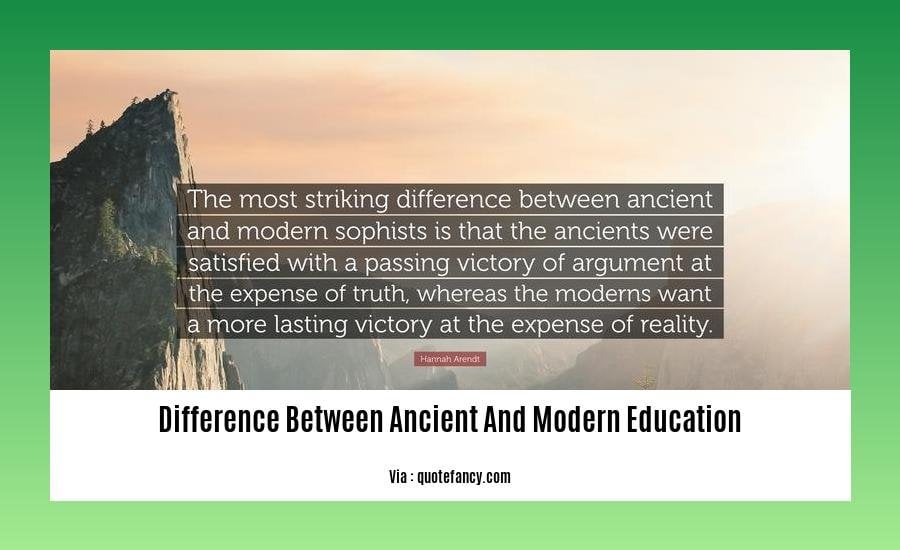
Ancient vs. Modern Education- Key Differences in Teaching and Learning
Key Takeaways:
- Memorization vs. Skills: Ancient education emphasized memorization and rote learning, while modern education focuses on developing critical thinking, problem-solving, and practical skills applicable to real-world situations.
- Passive vs. Active Learning: In the past, students were passive recipients of knowledge, primarily listening to lectures and memorizing information. Modern education emphasizes active learning, where students engage in hands-on activities, group projects, and interactive discussions to construct their understanding.
- Human-Environment Interaction: Modern education recognizes the interconnectedness of human society and the natural world, encouraging students to think critically about their impact on the environment and their roles in creating a sustainable future.
- Holistic Development: Education is no longer solely about academic achievement. Modern education strives to nurture the whole child, fostering social-emotional learning, creativity, resilience, and a lifelong love of learning.
- Grit and Resilience: Drawing inspiration from ancient philosophies, modern education emphasizes the importance of grit, resilience, and a growth mindset. Students are encouraged to embrace challenges, learn from their mistakes, and persevere in the face of setbacks.
Transformation of Pedagogical Practices
Let’s further examine the key differences in teaching and learning between ancient and modern education:
| Feature | Ancient Education | Modern Education |
|---|---|---|
| Knowledge Transmission | Primarily oral, passed down through generations, often with a focus on religious teachings. | Shared through diverse mediums, including textbooks, technology, and experiential learning, covering a broad spectrum of subjects. |
| Teacher’s Role | Highly respected figures of authority, the primary source of knowledge and dispenser of information. | Act as guides and facilitators, creating engaging learning experiences, encouraging exploration, questioning, and critical thinking. |
| Student’s Role | Expected to be attentive listeners, obediently memorizing and reciting information. | Active participants in their learning journey, encouraged to think critically, ask questions, collaborate with peers, and take ownership of their education. |
| Learning Environment | Formal and disciplined, with an emphasis on rote learning, strict adherence to rules, and often physical punishment. | More relaxed and interactive, designed to foster creativity, collaboration, and a love of learning through hands-on activities, group projects, and real-world applications. |
| Technology | Nonexistent in the formal sense. | An essential tool for learning, communication, and accessing information, transforming the way we teach and learn. |
Convergence and Evolution:
While modern education has undoubtedly diverged from its ancient roots, it has also integrated valuable lessons from the past. The emphasis on discipline, respect for teachers, and the transmission of cultural values remain essential components of a well-rounded education.
The evolution of education is a testament to our capacity for innovation and our unwavering pursuit of knowledge. As we move forward, it is essential to embrace the best of both worlds, combining the rigor and wisdom of ancient traditions with the creativity, inclusivity, and technological advancements of modern education to create learning experiences that empower all students to thrive in an ever-changing world.
Bridging the Gap – Integrating the Best of Both Worlds
We’ve explored the distinct characteristics of ancient and modern education, but the real magic happens when we bridge the gap between these two worlds, harnessing the strengths of each to create a truly holistic and effective educational experience.
Technology: Our Digital Bridge
Technology serves as a powerful bridge, connecting the timeless wisdom of the past with the boundless possibilities of the future. It allows us to access a wealth of information from across time periods and cultures, enabling us to learn from the successes and failures of those who came before us.
Imagine students exploring ancient ruins through virtual reality, interacting with historical figures through augmented reality simulations, or collaborating on projects with peers from around the globe through online platforms. Technology empowers us to break down barriers, foster global citizenship, and create truly interconnected learning experiences.
Medicine: Where Science Meets Compassion
In the field of medicine, bridging the gap between rigorous scientific research and compassionate patient care is paramount. Modern medicine has made remarkable advancements in our understanding of the human body and the treatment of diseases, thanks to the scientific method, technological innovations, and the tireless work of researchers and practitioners.
However, it is essential to remember that medicine is not solely about treating diseases; it is about caring for people. Patients are not simply collections of symptoms but complex individuals with unique needs, beliefs, and experiences. Therefore, integrating the latest scientific evidence with compassionate, patient-centered care is crucial for delivering truly effective and humane healthcare.
Training the Next Generation of Docs: Graduate Medical Education
Graduate medical education plays a vital role in shaping the next generation of physicians, equipping them with the knowledge, skills, and values to provide exceptional patient care. To effectively prepare future doctors for the challenges and rewards of the medical profession, it is essential to bridge the gap between theoretical knowledge and real-world practice.
This involves providing medical students with ample opportunities for hands-on experience through clinical rotations, simulations, and mentorship from experienced physicians. It also requires fostering critical thinking skills, problem-solving abilities, and a deep understanding of ethical principles and patient-centered care.
Future-Proofing Our Workforce: Skills for the 21st Century
The job market is evolving at an unprecedented pace, driven by technological advancements, globalization, and automation. To thrive in this dynamic landscape, students need to be equipped with a different set of skills than in previous generations.
Rote memorization and narrow technical skills are no longer sufficient. The jobs of the future will demand critical thinking, creativity, adaptability, communication, collaboration, and problem-solving abilities. Therefore, it is crucial to bridge the gap between education and industry needs, ensuring that curriculums are aligned with the skills and knowledge demanded by the modern workforce.
Bridging the gap between ancient and modern education is not about choosing one over the other but rather about harnessing the strengths of both to create a truly holistic and effective learning experience. By integrating the timeless wisdom of the past with the innovative spirit and technological advancements of the present, we can empower future generations to navigate the complexities of the 21st century and beyond.
- Unveiling Bernhard Caesar Einstein’s Scientific Achievements: A Legacy in Engineering - July 15, 2025
- Uncover who is Jerry McSorley: CEO, Family Man, Business Success Story - July 15, 2025
- Discover Bernhard Caesar Einstein’s Scientific Contributions: Unveiling a Legacy Beyond Einstein - July 15, 2025
